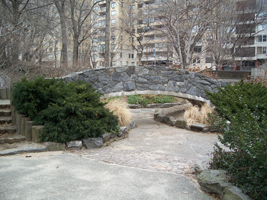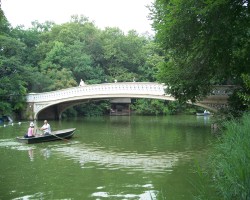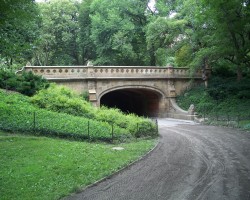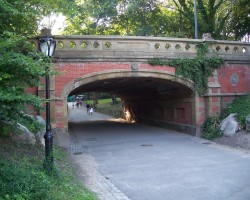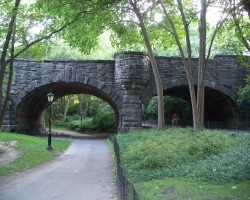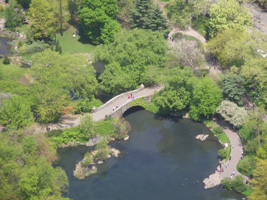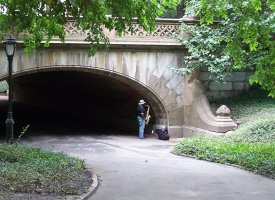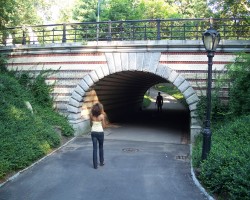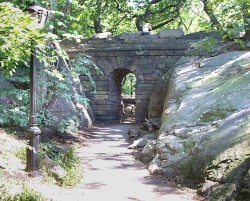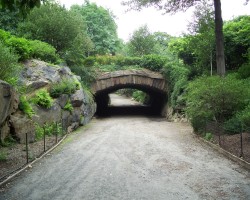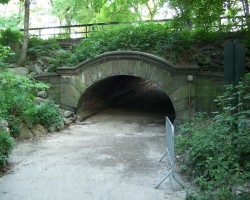Central Park Bridges
Bridges are an integral, yet often overlooked, part of Central Park. The park is home to around 50 bridges (depending on what you count as a bridge) in a variety of styles that are used both as prominant architectural enhancements and to conceal or bypass pathways and roads.
This page contains photos of the bridges in southern half of Central Park along with historic details and/or city Bridge Identification Numbers (BIN), where available and applicable. They are arranged in an approximate order from south to north. Although the Manhattan street grid does not extend into the park, street/avenue coordinates are often given to specify location relative to the island.
There are a number of web resources that cover Central Park and its bridges. The park's official site is CentralPark.com, although it contains limited information on the bridges. BridgeHunter.com covers historic bridges from around the country and has a page covering NYC. One of the best resources for information about the architecture and infrastructure history of NYC is Forgotten-NY.com and they have what is probably the definitive web resource on Central Park's Arch Bridges.
About BIN Numbers
Many of the bridges on this page are identified by BIN numbers that are posted on luminescent green and white signs on the bridge. As of the city's 2002 Bridge and Tunnel Annual Condition report, 31 of Central Park's bridges have BIN numbers.
In 1972, the State of New York developed a computerized system to store inventory and inspection data on bridges that are greater than 20 feet in length. In New York City, structures that are 20 feet in length or less, "mini-bridges," are tracked independently by the City. Each structure is distinguished by a separate Bridge Identification Number (B.I.N.).
A six-digit B.I.N. identifies a single structure or group of connected or associated structures, while the seven-digit B.I.N. identifies each of those connected or associated bridge structures individually. Each level of a bi-level bridge, each separate bridge structure in a parallel configuration, and each ramp attached to a main bridge is considered an individual structure and assigned its own unique B.I.N. for example, the Brooklyn Bridge has one six-digit B.I.N., 2- 24002, which incorporates the entire bridge. All ramps and secondary structures, as well as the main structure, are identified by their own seven-digit numbers, such as 2-24001-A, 2-24001-B, etc.
If the prefix (first number) of the B.I.N. is:
1, the bridge is considered part of the State bridge system. This number might include City bridges if maintenance is shared between City and State.
2, the bridge is considered part of the City bridge system. This number might include State bridges if maintenance is shared between City and State.
M, Q, or R, the bridge is a "mini-bridge," and is considered part of the City bridge system. They are located in Manhattan, Queens, or Staten Island, respectively.
If the suffix (last character) of the B.I.N. is:
1 through 6, the bridge is in parallel configuration. The left-most bridge in the Direction of Orientation has a last character of 1. The next left-most bridge has a last character of 2, and so on.
7 or 8, the bridge is in a bi-level configuration. Seven indicates the lower level and eight indicates the upper level.
0 or 9, the bridge is not in parallel or bi-level configuration.
A letter of the alphabet, the structure is a ramp physically attached to the main bridge. If more than one ramp is attached to the same span of the main bridge, the characters are assigned alphabetically starting with the left-most ramp in the Direction of Orientation. Other ramps attached to the bridge are assigned alphabetical characters in a clockwise direction.


